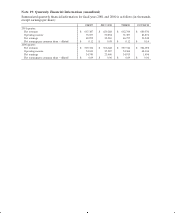Starbucks 2001 Annual Report Download - page 30
Download and view the complete annual report
Please find page 30 of the 2001 Starbucks annual report below. You can navigate through the pages in the report by either clicking on the pages listed below, or by using the keyword search tool below to find specific information within the annual report.
Note 18: Segment Reporting
The Company is organized into a number of business units which correspond to the Company’s
operating segments.
The Company’s North American retail business unit sells coffee and other beverages, whole bean
coffees, complementary food, hardware and merchandise through Company-operated retail stores in
the United States and Canada.
At the beginning of fiscal 2001, the Company combined its foodservice and domestic retail store
licensing operations to form the Business Alliances business unit. As a result of this internal
reorganization and the manner in which the operations of foodservice and domestic retail store
licensing are measured and evaluated as one combined business unit, the Company’s management
determined that separate segment reporting of Business Alliances is appropriate under SFAS No. 131,
“Disclosures about Segments of an Enterprise and Related Information.”All prior period disclosures
are restated as if Business Alliances had always been a separately reported segment.
The Company operates through several other business units, each of which is managed and
evaluated independently. These operations include international retail store licensing agreements,
grocery channel licensing agreements, warehouse club accounts, direct-to-consumer marketing
channels, joint ventures, international Company-operated retail stores and other initiatives related to
the Company’s core businesses.
Revenues from these segments include both sales to unaffiliated customers and sales between segments,
which are accounted for on a basis consistent with sales to unaffiliated customers.Intersegment revenues,
consisting primarily of product sales to subsidiaries and equity method investees, and other intersegment
transactions have been eliminated on the accompanying consolidated financial statements.
The accounting policies of the operating segments are the same as those described in the summary of
significant accounting policies in Note 1. Operating income represents earnings before “Interest and
other income, net,” “Internet-related investment losses” and “Income taxes.” No allocations of
overhead, interest or income taxes are made to the segments. Identifiable assets by segment are those
assets used in the Company’s operations in each segment. General corporate assets include cash and
investments, unallocated assets of the corporate headquarters and roasting facilities, deferred taxes and
certain intangibles. Management evaluates performance of the segments based on direct product sales
and operating costs.




















